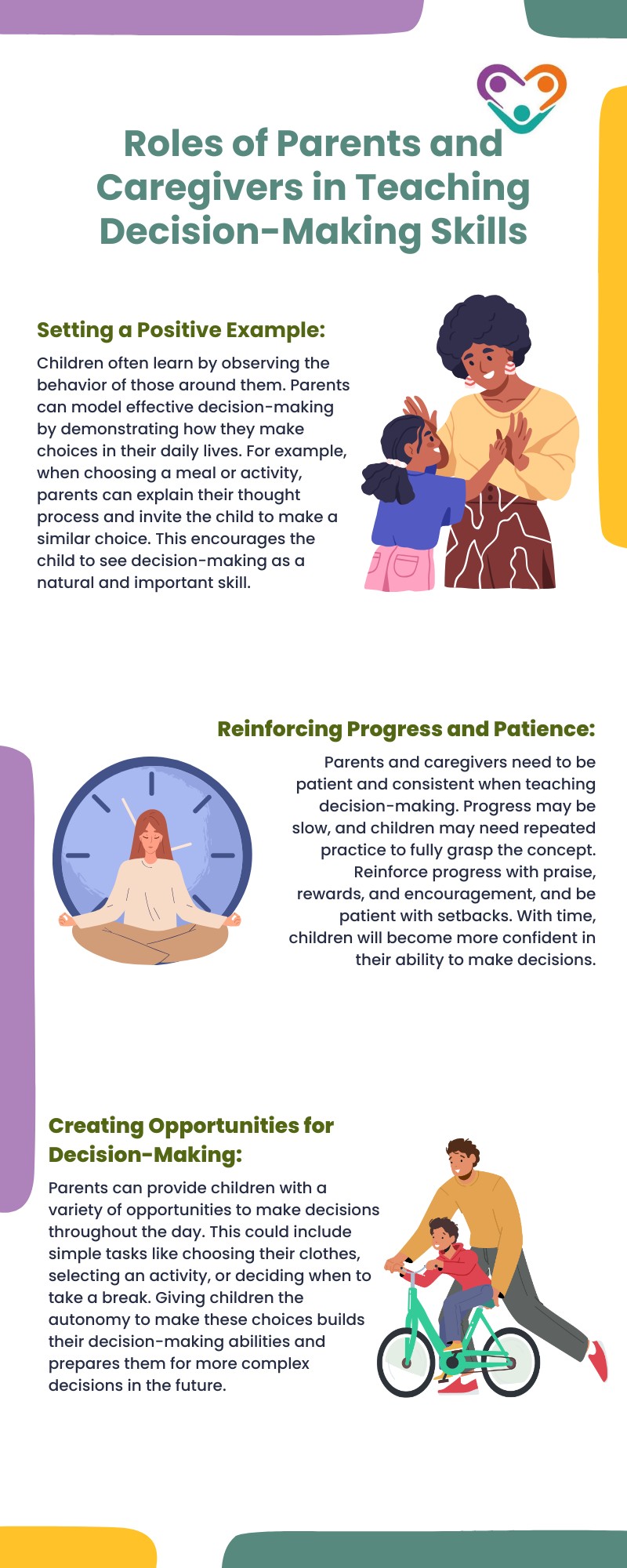Teaching children with autism decision-making skills is a crucial aspect of their development. It empowers them to make choices and take responsibility for their actions, enhancing their independence.
Children with autism may face challenges in processing information, understanding consequences, and navigating social situations. However, with the right strategies and support, they can develop essential decision-making skills, fostering growth and teaching independence that will serve them throughout their lives.
As such, we’re going to explore effective methods for teaching decision-making to children with autism and highlight why it’s important for their growth and well-being.
Why Learning Decision-Making Skills is Important
For autistic children, decision-making can be more difficult than for their neurotypical peers. Many children on the autism spectrum experience challenges with executive functioning skills, which include problem-solving, planning, and impulse control. These skills are fundamental when it comes to making informed decisions.
Helping children with autism learn how to make decisions in various contexts, from simple daily choices to more complex social scenarios, promotes greater independence and confidence.
Decision-making skills also play a critical role in fostering self-advocacy and self-determination. When children with autism learn how to make choices for themselves, they can better communicate their needs and preferences. This sense of autonomy is empowering and can lead to improved mental health and emotional regulation.
It’s important to keep in mind that every child is different, and the approach to teaching decision-making must be personalized. Some children may excel with structured routines, while others might benefit from visual aids or hands-on activities.
Understanding each child’s unique needs and strengths is essential in providing effective teaching methods.
That said, several methods can be used to teach decision-making skills to children with autism. It’s important to break down the process into manageable steps and provide consistent, positive reinforcement.
Without further ado, here are some effective techniques for promoting decision-making:

Use Visual Supports
Children with autism often benefit from visual aids to support their learning process. Visual schedules, charts, and choice boards are helpful tools in guiding them through decision-making tasks. By providing visual representations of options and their consequences, children can better understand the impact of their choices.
For example, a choice board can present two or three simple options for the child to choose from, such as “play with toys” or “coloring.” As the child selects their choice, they begin to understand the concept of making decisions. Over time, you can introduce more complex options and scenarios.
Visual supports are also beneficial for promoting independence. Children can refer to these tools independently, reducing reliance on adult intervention and building confidence in their ability to make decisions.
Role-Playing and Social Stories
Role-playing activities and social stories are another effective way to teach decision-making skills. These methods can help children with autism practice making decisions in various social contexts, which are often challenging for them.
Role-playing can involve scenarios where the child must choose between different actions based on the situation.
For instance, during a role-play, you might ask the child to decide what to do if they feel overwhelmed in a social setting. This could involve choosing between asking for help or taking a break in a quiet space.
Social stories are short narratives that describe specific social situations and offer guidance on appropriate behavior. By incorporating decision-making into social stories, you can demonstrate the potential outcomes of various choices, helping children understand the consequences of their actions.
Positive Reinforcement and Reward Systems
Positive reinforcement is an effective way to encourage decision-making in children with autism. When a child makes a decision, praise them for their effort, regardless of whether the choice was correct. This will encourage the child to continue making decisions, fostering a sense of accomplishment and confidence.
Reward systems, such as token economies or sticker charts, can be used to reinforce good decision-making.
For example, if a child makes a positive decision, they can earn tokens or stickers that can later be exchanged for a preferred activity or item. Reward systems help to motivate children to make decisions and understand that their choices have real-world consequences.
Break Down Tasks into Steps
When teaching decision-making, it’s essential to break down tasks into smaller, manageable steps. For children with autism, it can be overwhelming to make a decision when too many options are presented at once. By narrowing down choices and focusing on one step at a time, children can build the confidence they need to make informed decisions.
For example, if you are teaching a child how to choose what to eat for lunch, start with a few simple options like “sandwich” or “fruit.” Once they are comfortable with these choices, you can gradually increase the number of options or complexity of the decisions.
Breaking down tasks also makes it easier for children to understand the consequences of their decisions. By focusing on one aspect of the decision at a time, they can better grasp how each choice impacts the outcome.
The Role of Parents and Caregivers in Teaching Decision-Making
Parents and caregivers play a vital role in helping children with autism develop decision-making skills. By creating a supportive and consistent environment, parents can encourage children to practice decision-making in daily activities.
That said, the roles of parents and caregivers are as follows:

Teaching decision-making to children with autism is a gradual process that requires patience, consistency, and individualized strategies. These skills will not only improve the child’s ability to navigate daily life but will also empower them to become more independent and confident as they grow.
With the right support and encouragement, children with autism can learn to make informed decisions, advocate for themselves, and lead fulfilling lives. At Golden Care Therapy, we provide personalized ABA therapy in Florida, New Jersey, Indiana, New York, and Georgia.
We are dedicated to delivering compassionate, evidence-based care that empowers children to reach their full potential. Reach out to us todayfor more info!



